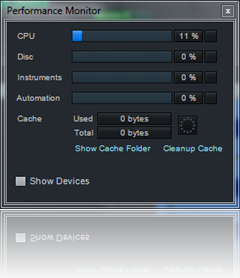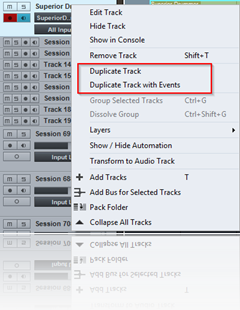First of all, for the beginners out there—Presonus is an Audio Creation Software and Hardware Company. Presonus’ Studio One v2 is a full featured DAW {Digital-Audio-Workstation—i.e. Avid Pro Tools, Apple Logic, Steinberg Cubase, Ableton Live} A DAW is what any music producer or engineer needs, to record, mix, and master any of their audio. I’ve been mixing for a few years now, and I’m learning something new every day. I’m just showing you why I personally, have chosen Studio One.
First of all, I have yet to try Pro Tools 10. I’ve heard nothing but fantastic things about it. I’m a former Pro Tools 9 HD user, as well as Logic Pro and Cubase. Once I came across Studio One, I was sunk. It only took a few handy features to catch my attention, to officially make the switch. *All DAW’s are pretty much just as powerful as the rest for general recording tasks—some, such as Ableton Live, are geared more towards the technical side of things, like creating sound from scratch. To each is own here…
In-Depth after the break:
Features I Love
FYI (Not saying that some of these features aren’t in other DAW’s, just comparing them themselves <3)
Performance (And how it compares) I recall being on my iMac (which was a powerhouse!) and using Logic Pro. It’s quite the heavy duty program, and you need a good system to run it. Thankfully it’s completely native and created by Apple—therefor it gets the best performance possible. I don’t think it would compete with Studio One on a PC.
(Pro Tools) Whether I was on Windows or Mac, I always loved Pro Tools, but it can overload real quick if you have too many virtual instruments and effects running. I found myself always live-re-recording my Superior Drummer tracks and converting them to audio tracks, so I could save performance by disabling the original Virtual Instrument (VI) track. Another issue I always had—when having too many VI tracks active at once—was bouncing or exporting audio. It would bring endless error messages if your system couldn’t handle the real-time bouncing functionality.
(Cubase) When I discovered Cubase, I realized how lightweight of a program it was. I was running it with about 1GB of RAM and a Dual-Core 2.13 GHz processor. That’s what I’m living with as we speak. It would run fine, with only some error messages while bouncing. I didn’t like the interface of Cubase at all. It felt… off to me. Nothing seemed to work as flawlessly as it did with Pro Tools.
In the end, (present day) I came across Studio One. I’d been wanting to try it for a long time after seeing that it was kind of an underdog of sorts in my circles. (Not in general; people love it, pros love it) Presonus seemed to have tickled my fancy just right. They deliver the best of all worlds. The lightweight functionality, (being able to run it with a low-end PC) and all the usual and fantastic functionality I got from Pro Tools. Cubase seemed to seriously lack some small perks the rest allowed.
When viewing the performance bar in Studio One, once all the drums and such are loaded, (with a good amount of tracks, and a couple active VI tracks) it chills at around 11% most of the time. Low-end PC and I’m getting unbeatable performance.
Main Interface. As you can see from the screenshots, it’s gorgeous, but not pretentious. Not all DAW’s will be receiving a design award I’ll tell you that… (If I had a larger monitor the interface would have virtually NO clutter whatsoever) Everything is streamlined. The interface you see in one spot, is only different when absolutely necessary elsewhere. And it’s great.
Those Small Perks I Was Talking About…
Inline Inserts. Say I were to throw “Pro EQ” on an audio track via the inserts menu on the left as usual. You can click on it and select expand, and you’ll see a small box with the Visual EQ drop down like a menu. Sure, it’s cool to get a kind of preview of the EQ you’ve applied—but it’s another thing to actually be able to tweak it without popping out the bulky settings window for the insert. It would get in the way if you simply wanted to throw a change you already have in mind on there. Sure you need it bigger to do some real mixing, but it’s a cool thing to have. This also appears in the mixer, or wherever else you may see your inserts menu.
 The Mix Window. Studio One has a great interface. It has a low clutter factor right from the start, mess around a bit and everything can be out of your way. The mixer has a few size settings, for when you have a couple tracks, or 100. There’s these skinny / tall buttons that allow you to view very skinny, limited sliders with titles. Even when they’re small you can click this little arrow to expand just that one tracks mixer, inline. So whether you need to save space or not, ALL options will still be available to you. Inserts are there, that inline insert box I talked about, that you can use while it’s inline. When you set it to ‘Tall’ you can view all sends and inserts spread out for you. That’s alright if you want to scroll through a 100 track project… Not so fun.
The Mix Window. Studio One has a great interface. It has a low clutter factor right from the start, mess around a bit and everything can be out of your way. The mixer has a few size settings, for when you have a couple tracks, or 100. There’s these skinny / tall buttons that allow you to view very skinny, limited sliders with titles. Even when they’re small you can click this little arrow to expand just that one tracks mixer, inline. So whether you need to save space or not, ALL options will still be available to you. Inserts are there, that inline insert box I talked about, that you can use while it’s inline. When you set it to ‘Tall’ you can view all sends and inserts spread out for you. That’s alright if you want to scroll through a 100 track project… Not so fun.
Context Menu Items. Before I knew much… The routine in Pro Tools for converting my Superior Drummer track into an audio track to restore performance was this. Send that track on a bus to a new audio track, record-enable both tracks, sit and wait in real-time while it re-recorded the track. Now in Studio One, I can just right click on any single tracks (or multiple) and click ‘Bounce Selection.’ It automagically does that for me, and allows me an option to throw it on a new track or not. If I want, I can keep it right on that VI track to save space.
I can also merge any events with a single click. They will bring it all the way to the beginning if I’d like. (sometimes that helps for those who don’t Quantize for timing) I can even merge events from separate tracks all at once. It’s beautiful.
QWERTY Keyboard Input Support for all VI’s. Thank god. I know that most of the DAW’s have this, but just thank god its there. What I’ve noticed that sets Studio One apart—is the QWERTY Latency. There’s virtually none. Usually there’s ridiculous amounts of latency unless you’re using an external. That’s been my experience, especially with Pro Tools. This ones input and output performance seems amazing.
SoundCloud. You can upload directly to SC from the app!
—There’s much more I love about it.. But this is the main stuff. The screenshots will do a little bit more explaining for you though. Feel free to comment with any questions!
—I have a new EP (“Imagine”) coming out.. I’ll be publishing it on my SoundCloud, but in the meantime I have some previews up, so go check them out! So far the project is just instrumental until I can get the right crew together to record some vocals. All guitar is recorded with the Peavey AmpKit LiNK module and the AmpKit iPhone application. Drums are done with Toontrack Superior Drummer.






Fantastic! I am also a studio one user and I love it man 😀
LikeLike
Too bad presonus is not windows 8 compatible. I just returned an entire system that would just not work. Too bad. they say they are compatible but their USB notes say ” may not work with some USB ports.” Lack of integrity issue here folks!
LikeLike
I was able to use it on Windows 8.
LikeLike
Brilliant article sir! I purchased Studio One Professional 2.6 two days ago and I must say that this program has made me a believer. I love my other DAW’s and the experience I have gained while using them but Studio One is undeniably the best of all worlds. -Edward Rogers | South Florida Producer
-12 Years Exp
Pro Tools 10 HD
Sonar X3
Studio One Pro 2.6
LikeLike
Good to hear! It’s amazing!
LikeLike
I have been producing music for 6-7 years by now and i tried any possible daw out there [Reason 4,5 cubase 4-5-6, FL studio, LOGIC pro 9, reaper etc…] , when i discovered studio one i found the best DAW out there because the workflow is so fast & comfortable so easy to use very friendly mixer that is easy to use and map automation with a single click!, this software obviously kicked all the daws back to the stone age….
LikeLike
On the contrary, I found Studio One the opposite of Cubase 5. For starters, the ridiculous size of the Icon buttons,too small to see properly wheras Cubase has large clearly defigned Icons. When using my controler keyboard the transport buttons did not work nor any way to program them unlike Cubase.
Navigating around studio One i found many things missing that I take for granted in Cubase. there is no “auto EQ” , no ” built in pitch correction”, no “harmoniser”, no “Play track”, no “studio monitor”.Lack of midi editing. Frustrating miniture windows to do anything in. “Why is everything so tiny”????
I could go on, suffice to say it’s all so subjective. Some prefer Presonus, some prefer Steinberg. Cubase DAW is a seasoned product that has matured into world class status and is in a league of its’ own, so don’t let anyone tell you otherwise!
Further,I find it hard to believe that anyone would buy a £500 product like Cubase without proper research then ditch it to buy the cheaper “studio one” and praise it as a better product!
NO WAY, I REPEAT, NO WAY IS PRESONUS BETTER THAN STEINBERG!
LikeLike